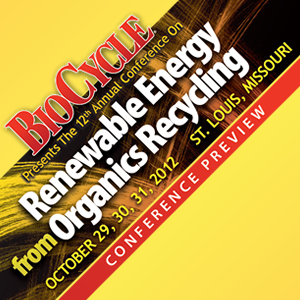Nora Goldstein
BioCycle September 2012, Vol. 53, No. 9, p. 4
Longevity has its advantages. After 53 years of publishing BioCycle and about 40 years of sponsoring conferences, we can state the following with confidence: our industry has a cyclical nature, and our progress is steady.
Let’s start with cyclical. There have been years where growth in composting and organics recycling has skyrocketed, for example, in the late 1980s and early 1990s when states were adopting bans on landfilling yard trimmings. And there have been cycles of energy “crises,” where the federal government sees the importance of weaning our country off of fossil fuels and pushes conservation, renewable energy and alternative fuels.
But when those policy pushes and incentives wane, it seems as though the boom years do as well. A very recent example is the U.S. Treasury’s 1603 tax incentive that paid for 30 percent of the capital costs of anaerobic digester projects that produce electricity. The 1603 grants originally were set to expire at the end of 2010, but were extended to the end of 2011. There was an exciting flurry of projects being developed and breaking ground, especially in the last two years. And projects are still being announced and developed, so it’s too early to assess if the pace has slowed down.
And this is where the reality of steady progress factors in — the true barometer for the medium and long-term health of our industry. It’s also where longevity is an advantage. Next month at BioCycle’s 12th Annual Conference on Renewable Energy From Organics Recycling in St. Louis (October 29-31), example after example will be cited of the progress being made in adoption of anaerobic digestion to process organic waste streams from municipal, agricultural and industrial sources. Presentations are no longer focusing on why we need to implement these renewable energy from organics recycling technologies and systems, but how to do more of it, how to make the projects in place work better, and how to expand markets for biogas and digester by-products. The level and quality of information exchange will be invaluable.
It is also steady progress that prepares us for the next uptick cycle. For each time the spotlight shines on our industry’s toolbox of technologies and systems (e.g., composting, anaerobic digestion) and the products they yield — compost, biogas and renewable fuels — we are better prepared to meet the demand. Fortunately, most equipment and service providers have a history of longevity as well, and are continually improving their systems’ performance, reliability and track record.
Equally important is that as the years go by and the number of projects in our industry steadily increases, we are better able to demonstrate the return on investment. This is measured in actual savings, e.g., not having to purchase electricity or heating oil, reducing fertilizer costs, realizing significant water savings — and revenues from product sales, carbon and renewable energy credits, etc. And don’t forget to tag on improved water and air quality, carbon sequestration and other environmental benefits, as well as jobs created by these enterprises and facilities.
We look forward to meeting you in St. Louis next month, where you will feel the energy and excitement among participants, speakers and trade show vendors who have reason to celebrate our steady progress and staying power.










